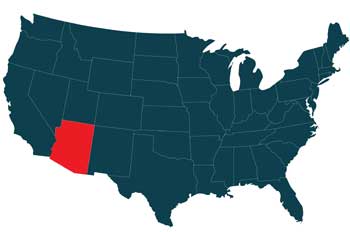Arizona Emergency Vehicle Light State Statutes
Arizona Emergency Vehicle Light Laws (2026 Statutes)
 Arizona law outlines clear and enforceable rules for the use of emergency vehicle lights, warning lamps, and sirens. The primary statutes governing these requirements are Arizona State Statute 28-101, Statute 28-947, and Statute 28-624. Together, these sections of Title 28 define which vehicles qualify as emergency responders, what color lights each may display, and what penalties apply to unauthorized lighting.
Arizona law outlines clear and enforceable rules for the use of emergency vehicle lights, warning lamps, and sirens. The primary statutes governing these requirements are Arizona State Statute 28-101, Statute 28-947, and Statute 28-624. Together, these sections of Title 28 define which vehicles qualify as emergency responders, what color lights each may display, and what penalties apply to unauthorized lighting.
Arizona’s Department of Transportation enforces strict standards for mounting height, flash pattern, and color visibility. Warning lamps must be visible from at least 500 feet in normal daylight, and only properly authorized agencies may operate red or blue emergency beacons. Private citizens, tow operators, construction contractors, and volunteers are restricted to amber, white, or other non-emergency colors that signal caution rather than command right-of-way.
For professionals and fleet operators seeking compliant equipment, Extreme Tactical Dynamics provides a full range of emergency vehicle lights including LED Light Bars, LED Warning Lights, and LED Strobe Lights that meet or exceed SAE J595 Class 1 and FMVSS 108 visibility standards.
Summary of Authorized Emergency Light Colors in Arizona
- Police & Law Enforcement: Red (forward-facing) and Blue (any direction) §28-947
- Fire Apparatus: Red (primary), White (secondary)
- Ambulance & EMS: Red or Red/White combination
- Volunteer Firefighters: Amber or White only
- Tow & Recovery Vehicles: Amber or White
- Construction & Utility Vehicles: Amber, Yellow, or White
- Pilot/Escort Vehicles: Amber and White (oversize load escort)
- Security & Private Patrol: Amber or White (permit required)
- School Buses: Amber (warning) and Red (stop-arm signal)
Police Lights
Under Statute 28-947, Arizona police vehicles must display a forward-facing red light visible from 500 feet and may use blue flashing lights to signal emergency response. These colors are exclusive to law enforcement. Local and county departments often equip vehicles with interior Dash Lights, exterior light bars, and rear flashers to enhance visibility.
City Police
City patrol cars use roof-mounted red and blue beacons plus alternating strobe flashers in the grille or rear deck. Some agencies also mount Grille and Surface Mount Lights for 360-degree coverage during traffic stops.
Sheriff’s Department
Sheriff vehicles follow the same color rules but often include higher-intensity strobes for rural patrols and long-distance identification.
State Troopers
The Arizona Department of Public Safety primarily uses blue lights with limited forward red, following §28-947 requirements. These units frequently deploy Police Lights rated for SAE J595 Class 1 performance.
Fire Truck Lights
Fire apparatus in Arizona must display flashing red lights visible from both front and rear. White lights may supplement red when additional forward illumination is necessary. Many departments use a combination of roof bars and perimeter strobes that comply with Statute 28-947. Departments seeking compliant options can equip vehicles with Fire Truck Lights and high-output LED Warning Lights for maximum daylight visibility.
Volunteer Firefighter Lights
Volunteers responding in personal vehicles may display amber or white caution lights only. They are not authorized to use red or blue beacons unless designated as official emergency vehicles under departmental control. Recommended products include Mini Light Bars or Volunteer Firefighter Lights mounted on the roof or dashboard for temporary response identification.
Ambulance Lights
Ambulances must display a forward-facing **red beacon**, often combined with white strobes for intersection clearing. These lights are defined under Statute 28-624. Many EMS agencies pair red light bars with rear amber flashers for added caution visibility. LED Strobe Lights meeting SAE J845 Class 1 standards are strongly recommended.
Tow Truck Lights
Tow and roadside assistance vehicles operate under §28-947 restrictions limiting color to amber and white. These colors signify caution but do not grant right-of-way. Arizona explicitly prohibits tow trucks from displaying red or blue lamps that resemble police or fire units. Operators should use Tow Truck Lights or Grille and Surface Mount Lights equipped with amber LEDs for compliant roadside visibility.
Construction Vehicle Lights
Road maintenance and utility vehicles are required to use **amber, yellow, or white lights** that alert approaching traffic of slow or stationary equipment. These lamps are regulated by Statute 28-947. Fleet managers can ensure compliance by selecting Construction Lights and Work and Scene Lights that meet SAE J845 Class 2 specifications.
Utility Vehicle Lights
Utility and power-company trucks responding to outages or emergencies may use amber and white lighting under §28-947 when parked or operating within traffic lanes. Many fleets integrate LED Warning Lights and Work and Scene Lights on service bodies for perimeter illumination.
Pilot and Escort Vehicle Lights
 Pilot cars guiding oversize loads are authorized to display amber and white lights only while escorting. Under Statute 28-947, these lights must not be used to imply emergency authority. Pilot Car Lights and amber Stick Lights offer excellent compliance options.
Pilot cars guiding oversize loads are authorized to display amber and white lights only while escorting. Under Statute 28-947, these lights must not be used to imply emergency authority. Pilot Car Lights and amber Stick Lights offer excellent compliance options.
Security Vehicle Lights
Private patrol or security companies may install amber or white warning lights if granted a local permit. Lights cannot flash red or blue, and vehicles must not imitate law-enforcement patterns. Appropriate solutions include Mini Light Bars or Hideaway Strobe Lights set to amber flash modes.
Snow Plow Lights
In Arizona’s high-elevation regions, snowplows and road-clearing vehicles operate with amber and white rotating or flashing lights under §28-947. These increase visibility in low-contrast weather and warn drivers of reduced speeds.
School Bus Lights
School buses must display alternating amber lights when slowing to stop and red flashing lights during passenger loading or unloading. Both are strictly regulated by §28-947.
Penalties and Enforcement
Operating any light configuration that mimics an emergency vehicle is a misdemeanor in Arizona and may escalate to felony charges for impersonation. Violations of Statute 28-947 can result in fines, license suspension, and equipment impoundment. Using unauthorized red or blue lights is explicitly prohibited for civilians.
To stay compliant, vehicle owners should select certified amber or white LED Strobe Lights, Amber LED Strobe Lights, or White LED Strobe Lights designed for caution use rather than emergency response.
Contact Information
For clarification or permit information, contact the Arizona Highway Patrol at 602-542-0362. Availability and extensions may vary; always verify with the most recent state directory.
Disclaimer
The Arizona Emergency Vehicle Light Laws guide was prepared by Extreme Tactical Dynamics for informational purposes only. It reflects our interpretation of current laws as published by the Arizona Legislature and Department of Transportation. We make no claim to the accuracy or completeness of this information. Regulations may change without notice.
Always consult local law enforcement or your state highway patrol before installing or operating emergency lighting equipment. Extreme Tactical Dynamics assumes no liability for misuse or misinterpretation of any product or statute.
For national coverage and other state requirements, view all state light laws.


